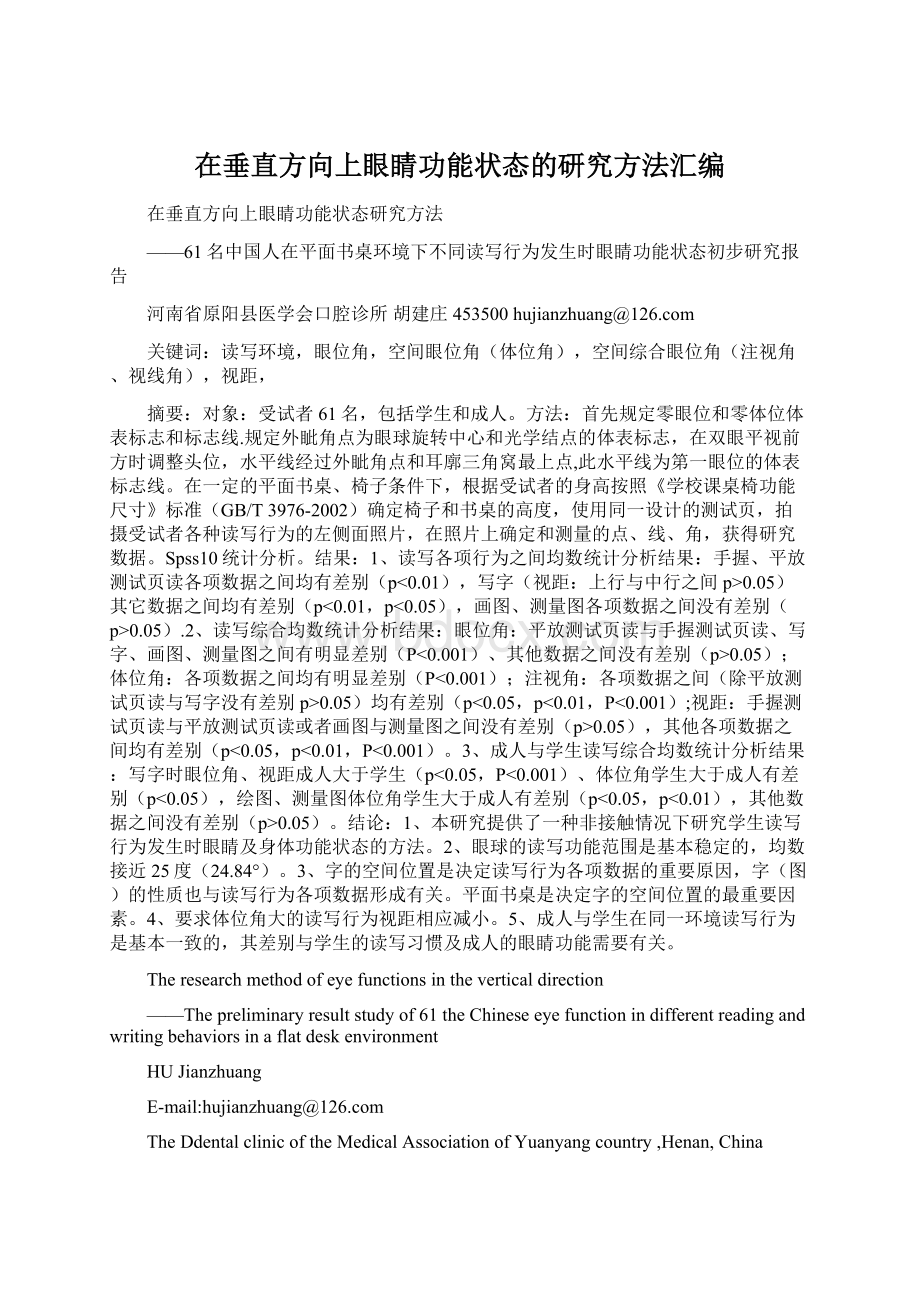在垂直方向上眼睛功能状态的研究方法汇编.docx
《在垂直方向上眼睛功能状态的研究方法汇编.docx》由会员分享,可在线阅读,更多相关《在垂直方向上眼睛功能状态的研究方法汇编.docx(48页珍藏版)》请在冰豆网上搜索。

在垂直方向上眼睛功能状态的研究方法汇编
在垂直方向上眼睛功能状态研究方法
——61名中国人在平面书桌环境下不同读写行为发生时眼睛功能状态初步研究报告
河南省原阳县医学会口腔诊所胡建庄453500hujianzhuang@
关键词:
读写环境,眼位角,空间眼位角(体位角),空间综合眼位角(注视角、视线角),视距,
摘要:
对象:
受试者61名,包括学生和成人。
方法:
首先规定零眼位和零体位体表标志和标志线.规定外眦角点为眼球旋转中心和光学结点的体表标志,在双眼平视前方时调整头位,水平线经过外眦角点和耳廓三角窝最上点,此水平线为第一眼位的体表标志线。
在一定的平面书桌、椅子条件下,根据受试者的身高按照《学校课桌椅功能尺寸》标准(GB/T3976-2002)确定椅子和书桌的高度,使用同一设计的测试页,拍摄受试者各种读写行为的左侧面照片,在照片上确定和测量的点、线、角,获得研究数据。
Spss10统计分析。
结果:
1、读写各项行为之间均数统计分析结果:
手握、平放测试页读各项数据之间均有差别(p<0.01),写字(视距:
上行与中行之间p>0.05)其它数据之间均有差别(p<0.01,p<0.05),画图、测量图各项数据之间没有差别(p>0.05).2、读写综合均数统计分析结果:
眼位角:
平放测试页读与手握测试页读、写字、画图、测量图之间有明显差别(P<0.001)、其他数据之间没有差别(p>0.05);体位角:
各项数据之间均有明显差别(P<0.001);注视角:
各项数据之间(除平放测试页读与写字没有差别p>0.05)均有差别(p<0.05,p<0.01,P<0.001);视距:
手握测试页读与平放测试页读或者画图与测量图之间没有差别(p>0.05),其他各项数据之间均有差别(p<0.05,p<0.01,P<0.001)。
3、成人与学生读写综合均数统计分析结果:
写字时眼位角、视距成人大于学生(p<0.05,P<0.001)、体位角学生大于成人有差别(p<0.05),绘图、测量图体位角学生大于成人有差别(p<0.05,p<0.01),其他数据之间没有差别(p>0.05)。
结论:
1、本研究提供了一种非接触情况下研究学生读写行为发生时眼睛及身体功能状态的方法。
2、眼球的读写功能范围是基本稳定的,均数接近25度(24.84°)。
3、字的空间位置是决定读写行为各项数据的重要原因,字(图)的性质也与读写行为各项数据形成有关。
平面书桌是决定字的空间位置的最重要因素。
4、要求体位角大的读写行为视距相应减小。
5、成人与学生在同一环境读写行为是基本一致的,其差别与学生的读写习惯及成人的眼睛功能需要有关。
Theresearchmethodofeyefunctionsintheverticaldirection
——Thepreliminaryresultstudyof61theChineseeyefunctionindifferentreadingandwritingbehaviorsinaflatdeskenvironment
HUJianzhuang
E-mail:
hujianzhuang@
TheDdentalclinicoftheMedicalAssociationofYuanyangcountry,Henan,China
Keywords:
Thereadingorwritingbehaviour;Theeyepositionangle;Thebodypositionangle;Thewatchingangle;Thesightdistance;Thereadingorwritingenvironments
Abstract
OBJECTIVE:
The61participants,includingstudentsandadults.
METHODS:
Stipulations:
Surfacemarksofzeroeyepositionandzeropositionofthebodyarethepointoflateralcanthuscornerandthemostuppointoftheonesidetriangularfossaofauricle.Thehorizontallinethroughtheuppointsandisprovidedasthesurfacemarkofthefirstpositionofeyes.Thepointspecifiedofthelateralcanthuscorneristhebodysurfacemarkoftherotationcenterandoftheopticalnodeoftheeyes.Undertheconditionofthesamedeskandchair,accordingtotheGB/T3976-2002todeterminetheheightofthechairanddesk,usingthesametestpagedesigned,tookphotosoftheleftsideofthesubjectsasreadingorwriting,inthephotoidentifyingandmeasuringthepointsandlinesandangles,accesstotheresearchdata.Statisticalanalysis:
spss10.
RESULTS:
1,Themeanofstatisticalanalysisresultsofallthebehaviorofreadingorwriting:
Handing,flattingtestpagetoreadallthedatabetweenhavedifferences(p<0.01),writing(sightdistance:
betweentheuprowandthemiddlerowp>0.05)isdifferencebetweentheotherdata(p<0.01,p<0.05).Drawingormeasuringfigurethereisnodifferencebetweenthevariousdata(p>0.05).2、Thecomprehensivemeanofreadingorwritingstatisticalanalysisresults:
Theeyepositionangle(EPA):
Betweenthedatumofflattingtestpagereadingwiththedataofotherbehaviourhaveobviousdifferences(p<0.001)。
Thereisnodifferencebetweentheotherdata(p>0.05).Thespacialeyepositionangle{SEPA[positionangle](PA)}:
Betweenthevariousdatahaveobviousdifference(P<0.001).Thespacialcomprehensiveeyeangle{SCEPA[thesightlineangle(SLA):
betweenthevariousdata(theexceptionofthedatabetweenflattestpagereadingwiththewritingisnodifferencep>0.05)therearedifferences(p<0.05,p<0.01,p<0.001).Thesightdistance(SD):
betweenhandingtestpagereadingandflattingtestpagereadingorbetweenpaintingandmeasuringfigure,thereisnodifference(p>0.05),therearedifferencesbetweenthedataofotheritems(p<0.05,p<0.01,p<0.001).3,Thecomprehensivemeanstatisticalanalysisresultsbetweentheadultsandthestudentstoreadandwrite:
writing:
BythedataoftheEPAortheSDtheadultsisgreaterthanthestudents(p<0.05,p<0.001)andthestudentsPAaregreaterthantheadults(p<0.05).Thedataofdrawingandmeasuringfigure:
ThePAofthestudentsaregreaterthantheadults(p<0.05,p<0.01).Theotherdatatherearenodifferences(p>0.05).CONCLUTIONS:
1.Thisstudyprovidesamethodofstudyingtheeyesfunctionalstatusof61Chinessinanoncontactcaseintheverticaldirectionwhenreadingorwritingbehavioroccurring.2,Thefunctionscopeofeyeballsasreadingandwritingisbasicallystable,themeaniscloseto25degrees(24.84°)3,Thespacepositionofthewordsisoneoftheimportantreasonstodecidevariousdataoftheeyefunctionswithreadingorwritingbehaviorstakeplacing.Thenatureoftheword(figure)isalsorelatedtothedata.4,WhenthePAincreaseswiththeSDdecreasesduringreadingorwritingbehaviors.5,Asadultsandstudentsinthesameenvironment,readingandwritingbehaviorisalmostthesame,itsdifferenceliewiththehabitsofstudents'readingandwritingandtheneedofadultseyesfunction.
在眼科视光学中和眼生理学中,水平方向上眼睛的功能状态研究较多,例如眼睛的集合功能,而在垂直方向上眼睛的功能状态研究较少。
但是,在实际生活中,需要了解眼睛在垂直方向上的功能状态,譬如:
目前公认的学生近视的主要环境因素是在读写时长期近距离用眼[1][2],这就需要了解学生读写时的眼睛除了集合以外的其它功能状态,分析眼睛功能状态与环境因素的关系。
本文通过61名中国人在平面书桌环境下不同读写行为发生时眼睛功能状态的研究方法及结果来说明在垂直方向上研究眼睛功能状态的方法。
Inthevisualopticsandphysiologyofophthalmology,theresearchoftheeyefunctionstateinthehorizontaldirectionismorethenitintheverticaldirection.Suchasconvergence.However,inreallife,itisneedtounderstandthefunctionalstateoftheeyesintheverticaldirection,suchas:
themainlyenvironmentalfactorscurrentlyrecognizedofstudentsmyopiaiscloseworkinalong-termreadingorwriting[1][2].Exceptconvergence,otherfunctionalstateofeyesrequiresanunderstanding,theanalysisoftherelationshipbetweenfunctionalstatusandenvironmentalfactorsisneed.Theresearchmethodsandresultsofthefunctionalstateofeyesintheverticaldirectionisobtainedbystuddingthe61Chinesereadingandwritingbehaviorsinvariesformsontheflatdeskenvironment.
1、对象和方法
1·1、对象:
随机选取在河南省原阳县医学会口腔诊所就诊的口腔病人、家属及本所的医生共计61人作为受试者。
其中非学生(成人)19人,学生42人,男性27人,女性34人;年龄在7——48岁之间,平均年龄19.7岁。
其中学生的组成为:
小学生17名,初中生13人,高中生11人,大学生1人。
1·2、方法:
通过一定条件下测量受试者读写行为侧面照获得研究数据。
1·2·1、零眼位零体位确定方法:
规定一侧眼外眦角点(上下睑皮肤在外眦后外侧的连接点,以下简称外眦点)与同侧耳廓三角窝的最上点的连线与地平面平行时的第一眼位为零眼位,此时的体位为零体位,该连线代表零眼位(零体位)时视轴、光轴在体表的标志线(图1,2)。
1.OBJECTSANDMETHODS
1.1.Objects、The61objectsrandomlyisselectedaspatientsandfamilymembersandthedoctorsinthedentalclinicofmedicalassociationofYuanyangCountyHenanprovince,includingadults19andstudents42,males27,females34;between7--48yearsold,theaverageageis19.7yearsold.Thestudentsarecomposedofelementaryschoolstudents17,juniorhighschoolstudents13,highschoolstudents11,universitystudents1.
1.2.Methods
undercertainconditions,theresearchdataisobtainedbymeasuringthephotosoftheleftsideofthesubjectsreadingorwritingbehaviors.
1.2.1.themethoddeterminingzeroeyeposition(ZEP)andzerobodyposition(ZBP):
Thefirsteyepositionstipulatedbythelinewhichpassingthroughthepointofthelateralcanthusangular(PLCA)[Thejunctionpointofupperandlowereyelidskinlayinginoutercanthusposterolateral,hereinafterreferredtoas:
canthuspoint(CP)]ofoneeyewiththeuppointsoftriangularfossaoftheauricle(UPTFA)inthesamesidesandparallelingtothehorizontalplaneistheZEP,thebodypositionisthezeroposition.ThelinerepresentsthesurfacemarklineofthevisualaxisandopticalaxisaseyeinZEP(ZBP)(Figure1,2).
1·2·2、眼球旋转中心和光学结点的确定:
规定眼球旋转中心与光学结点为一个点,外眦角点为其在体表的标志点。
1.2.2.Determiningtheeyeballrotationcenterandtheopticalnode:
Theeyeballrotationcenterandtheopticalnodeasonepointisstipulated,theCPistheipsilateralsurfacelandmarksofthestipulatedpoint.
1·2·3、测试页的设计和读写行为项目:
设计一种能够确定读写位置的测试页(图3),该测试页的页头采用“智能测试”式样,宋体4号黑体字,读的字有3行,每行10个不相干的词组,上行与中行之间间距是88mm,中行与下行之间是121mm。
读书:
读书分为手握测试表和把测试表放置在书桌平面上阅读两种情况,上中下三行词在两种情况下分别读一遍,分为六种测试指标;写字:
分为写字和绘图,写字为3个测试项目,即测试页的上、中、下分别填写:
姓名、住址、爱好三种情况。
绘图分为2个测试项目,在上下两个空格里分别画出一个30度角和一个40度角。
测量图:
使用量角器来测量所绘的两个图。
一共13个读写行为项目。
1.2.3.Thereadingandwritingtestpagedesignedandbehaviorprojects:
1.2.3.1.Thereadingandwritingtestpage:
Atestpagetodeterminethepositionsofawordreadingorwritingisdesigned(Figure3).The"intelligencetest"styleisusedinthetestpageheader,thewordsinthepagearetheBoldfaceArialNo.4.Thereadingwordsaredividedinto3rows.10unrelatedphrasesisineachrow.Thespacingbetweentheuprowandthemiddlerowis88mm,betweenthemiddlerowandthedownrowis121mm.
1.2.3.2.Behaviorprojects:
Reading:
Thewordsineveryrowswerereadinthetwoformsholdingthetestpageandthetestpageplacedonthedesk,theyaredividedintosixtestindicators.writing:
Writingisdividedintotwocases:
writingwordsanddrawing,writingisdividedinto3testitems:
fillinthename(uprow),address(middlerow),hobby(lowerrow)inthetestpage.Thedrawingisdividedinto2testitems:
A30degreeangleanda40degreeanglewerepaintedintheupperblankandlowerblank.Measuringpictures:
measuringthetwopainteddrawings.Allreadingandwritingbehaviorsis13projects.
1·2·4、测试用书桌椅子:
为市售书桌椅子,符合中国《学校课桌椅功能尺寸》标准(GB/T3976-2002)[4],高度调整非常方便,书桌的桌面尺寸为65cm×45cm;高度调节范围:
书桌为52——76cm,椅子为30——42cm。
1.2.4.Deskandchair:
ThedeskandchairusedinthetestconformingtotheChineseStandard"Functionalsizesofchairsanddesksforeducationalinstitutions"(GB/T3976-2002)[4]waspurchasedinthemarket,theirheightisveryconvenienttoadjust.Thedesktopsizeis65cm*45cm;theheightadjustmentrange:
thedeskisbetween52--76cm,thechairIsbetween30--42cm.
1·2·5、受试者使用书桌椅子高度确定方法:
根据《学校课桌椅功能尺寸》(GB/T3976-2002)规定标准和受试者的身高确定书桌椅子的高度。
1.2.5.Thedeterminingmethodofdeskandchairheight:
Asthe"Functionalsizesof